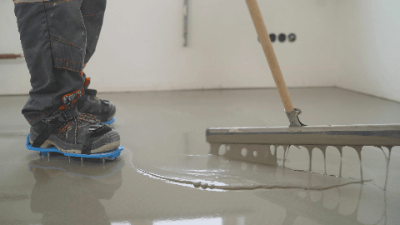What Is Self-Leveling Material?
 Self-leveling materials are gypsum or cement-based natural flow materials.
Self-leveling materials are gypsum or cement-based natural flow materials.
Self-leveling material is characterized by its ability to form a level and uniform level simply by pouring, and is also known as a leveler.
It is a revolutionary flooring material when compared to mortar, which has a similar role to that of self-leveling materials. While mortar finishes vary greatly depending on the skill of the craftsman, self-leveling material can be poured in and then broken in with a tonneau to complete a smooth floor base quickly.
Uses of Self-Leveling Material
Self-leveling materials are used to prepare floor subfloors with a smooth concrete surface.
Applications include buildings, condominiums, schools, hospitals, factories with heavy vehicles such as forklifts, parking lots, food factories, kitchens, and waterproof basements on rooftops. It is also used for underground adjustment in the preliminary stage of applying finishing materials such as tiles and other floor coverings.
Compared to mortar, which performs a similar function, self-leveling materials are more expensive in terms of material cost, but the short construction period helps to keep costs down.
However, it is difficult to obtain the thickness of self-leveling material in a single installation, and overlaying is required for thicknesses of 20 mm or more. In such cases, mortar is more suitable.
Principle of Self-Leveling Material
The principle of the self-leveling method using self-leveling materials is that a slurry (suspension) of gypsum and mortar poured onto the floor surface naturally flows to form a smooth floor surface.
The self-leveling process follows the following steps:
1. Preparation Before Construction
Pre-construction preparation includes level checking and marking. Marking out is the process of drawing out reference lines that serve as horizontal and central positions, such as the centerlines of columns and finished surfaces of walls. To prevent the self-leveling material from leaking outside, gaps are filled with mortar to prevent direct sunlight and wind.
2. Preparation of the Substrate
The substrate is cleaned with a special brush as a pre-treatment. Oil and protrusions are treated so that the self-leveling material and the floor can bond well.
3. Primer Application
Primer is applied and allowed to dry to provide adhesion to the subfloor surface. Primer is a base coat applied to improve the adhesion of materials that do not bite well to paint.
4. Placing Self-Leveling Material
After completing the above preliminaries, the self-leveling material is poured. When pouring the leveling material, ripples and air bubbles generated from the frame may remain as shapes, so if necessary, use a trowel to even out the material.
Details are matched to the ink or level point using a trowel. Finish by pouring gently, quickly, and evenly.
5. Curing and Drying
After pouring is completed to the finish level, the curing period begins. Avoid rapid drying until curing is complete. Close the windows to stop ventilation and reduce surface wrinkles caused by wind.
After curing is complete, the self-leveling material is still in a state of excessive moisture, so once curing is confirmed, windows are opened to improve ventilation and promote drying.
6. Finish Inspection and Rework
Finally, as a pre-completion inspection, we inspect the level of the building after it is ready for walking. We check all areas for joints, joints, and height differences. Any joints, bubbles, etc. that may have occurred will need to be corrected.
Types of Self-Leveling Materials
Self-levelling materials can be classified into two categories: gypsum-based and cement-based.
1. Gypsum-Based Self-Leveling Material
It has the property of not expanding or contracting during curing due to hydration reaction. This gypsum-based product has high dimensional stability and is resistant to floating and cracking.
2. Cement-Based Self-Leveling Material
Many cementitious materials feature high strength, and some can be used externally. After curing, they are also characterized by their resistance to water.